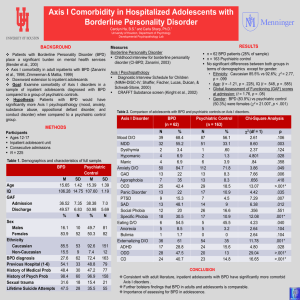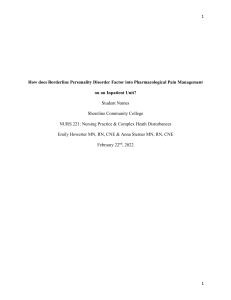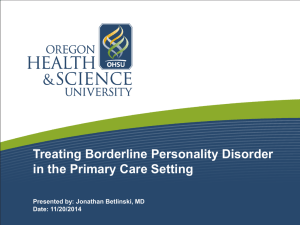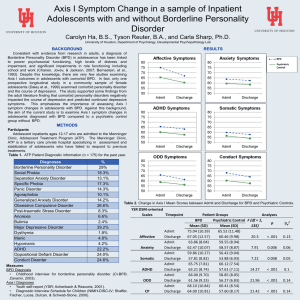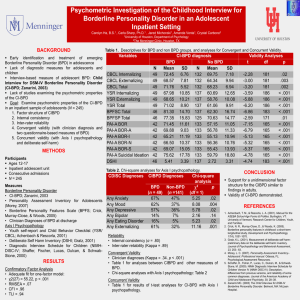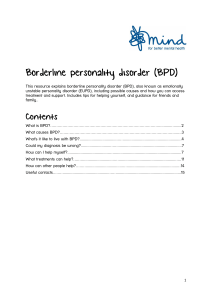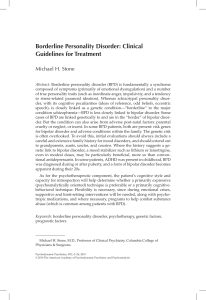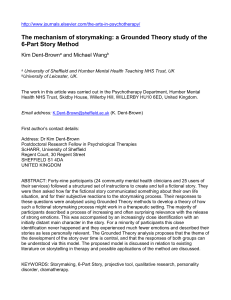The Downward Extension of the Trust Task to Adolescence
advertisement
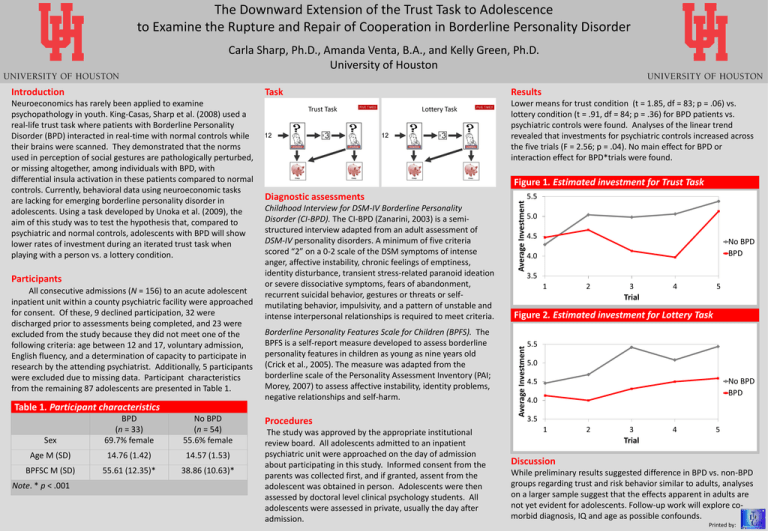
The Downward Extension of the Trust Task to Adolescence to Examine the Rupture and Repair of Cooperation in Borderline Personality Disorder Carla Sharp, Ph.D., Amanda Venta, B.A., and Kelly Green, Ph.D. University of Houston Task Participants All consecutive admissions (N = 156) to an acute adolescent inpatient unit within a county psychiatric facility were approached for consent. Of these, 9 declined participation, 32 were discharged prior to assessments being completed, and 23 were excluded from the study because they did not meet one of the following criteria: age between 12 and 17, voluntary admission, English fluency, and a determination of capacity to participate in research by the attending psychiatrist. Additionally, 5 participants were excluded due to missing data. Participant characteristics from the remaining 87 adolescents are presented in Table 1. Table 1. Participant characteristics Sex BPD (n = 33) 69.7% female No BPD (n = 54) 55.6% female Age M (SD) 14.76 (1.42) 14.57 (1.53) BPFSC M (SD) 55.61 (12.35)* 38.86 (10.63)* Note. * p < .001 Lower means for trust condition (t = 1.85, df = 83; p = .06) vs. lottery condition (t = .91, df = 84; p = .36) for BPD patients vs. psychiatric controls were found. Analyses of the linear trend revealed that investments for psychiatric controls increased across the five trials (F = 2.56; p = .04). No main effect for BPD or interaction effect for BPD*trials were found. Figure 1. Estimated investment for Trust Task Diagnostic assessments Childhood Interview for DSM-IV Borderline Personality Disorder (CI-BPD). The CI-BPD (Zanarini, 2003) is a semistructured interview adapted from an adult assessment of DSM-IV personality disorders. A minimum of five criteria scored “2” on a 0-2 scale of the DSM symptoms of intense anger, affective instability, chronic feelings of emptiness, identity disturbance, transient stress-related paranoid ideation or severe dissociative symptoms, fears of abandonment, recurrent suicidal behavior, gestures or threats or selfmutilating behavior, impulsivity, and a pattern of unstable and intense interpersonal relationships is required to meet criteria. Borderline Personality Features Scale for Children (BPFS). The BPFS is a self-report measure developed to assess borderline personality features in children as young as nine years old (Crick et al., 2005). The measure was adapted from the borderline scale of the Personality Assessment Inventory (PAI; Morey, 2007) to assess affective instability, identity problems, negative relationships and self-harm. Procedures The study was approved by the appropriate institutional review board. All adolescents admitted to an inpatient psychiatric unit were approached on the day of admission about participating in this study. Informed consent from the parents was collected first, and if granted, assent from the adolescent was obtained in person. Adolescents were then assessed by doctoral level clinical psychology students. All adolescents were assessed in private, usually the day after admission. 5.5 Average Investment Neuroeconomics has rarely been applied to examine psychopathology in youth. King-Casas, Sharp et al. (2008) used a real-life trust task where patients with Borderline Personality Disorder (BPD) interacted in real-time with normal controls while their brains were scanned. They demonstrated that the norms used in perception of social gestures are pathologically perturbed, or missing altogether, among individuals with BPD, with differential insula activation in these patients compared to normal controls. Currently, behavioral data using neuroeconomic tasks are lacking for emerging borderline personality disorder in adolescents. Using a task developed by Unoka et al. (2009), the aim of this study was to test the hypothesis that, compared to psychiatric and normal controls, adolescents with BPD will show lower rates of investment during an iterated trust task when playing with a person vs. a lottery condition. Results 5.0 4.5 No BPD BPD 4.0 3.5 1 2 3 4 5 Trial Figure 2. Estimated investment for Lottery Task Average Investment Introduction 5.5 5.0 No BPD BPD 4.5 4.0 3.5 1 2 3 4 5 Trial Discussion While preliminary results suggested difference in BPD vs. non-BPD groups regarding trust and risk behavior similar to adults, analyses on a larger sample suggest that the effects apparent in adults are not yet evident for adolescents. Follow-up work will explore comorbid diagnosis, IQ and age as possible confounds. Printed by:

